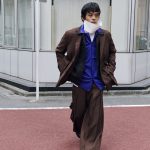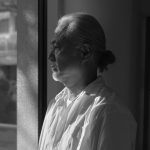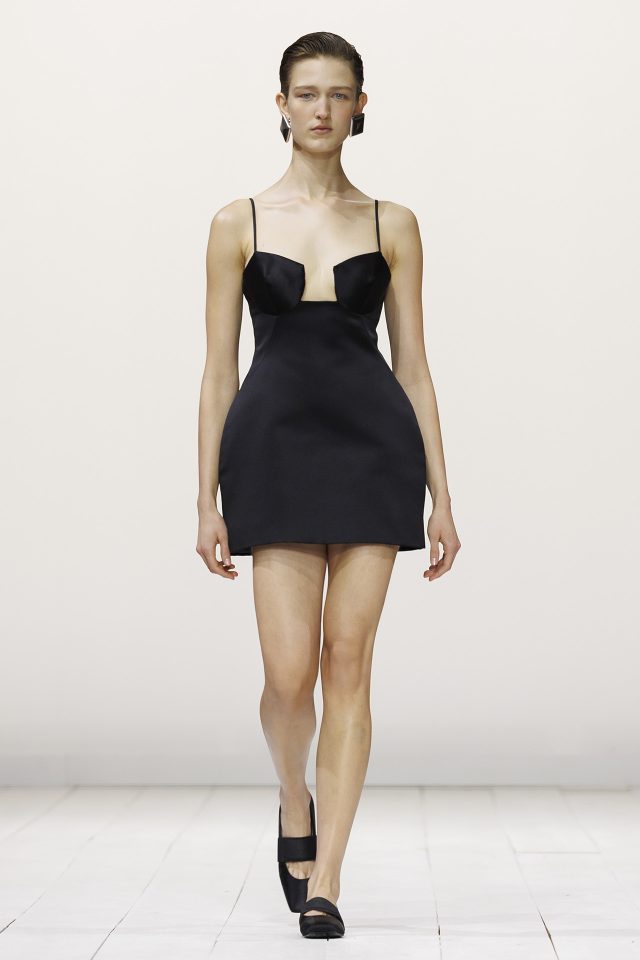ファッションジャーナリスト・大内順子インタビュー
Junko Ouchi
Photography: Hidemasa Miyake
Interview & text: Miwa goroku
まだパスポートを取得することすらも困難だった時代、海外のファッションにまさか手が届くとは思いもしなかった時代に、単身で何度も渡欧を繰り返しながら数多くのメゾンの扉を叩き続け、日本の、ひいては世界のファッションジャーナリズムのひとつの原型を作り上げたのが、ここに紹介する大内順子だ。その最も知られるところに、「ファッション通信」*というテレビ番組があるが、この番組の洗礼を受け、ファッション業界を志したという人は、デザイナーやスタイリストはもちろん、編集者のなかにも少なくない。大内順子が歩んできたファッション人生とは?今に対する考察も交えながら語ってもらった。
ファッションジャーナリスト・大内順子インタビュー
Magazine
*You’ll find the English text after the Japanese.
(この取材が行われた2年後、大内順子氏は2014年10月30日、川崎市内にある自宅で死去した。80歳でした。大内氏の生前のファッション業界に与えた偉大な功績を称えるとともに、謹んで哀悼の意を表します。)
まだパスポートを取得することすらも困難だった時代、海外のファッションにまさか手が届くとは思いもしなかった時代に、単身で何度も渡欧を繰り返しながら数多くのメゾンの扉を叩き続け、日本の、ひいては世界のファッションジャーナリズムのひとつの原型を作り上げたのが、ここに紹介する大内順子だ。その最も知られるところに、『ファッション通信』*というテレビ番組があるが、この番組の洗礼を受け、ファッション業界を志したという人は、デザイナーやスタイリストはもちろん、編集者のなかにも少なくない。大内順子が歩んできたファッション人生とは?今に対する考察も交えながら語ってもらった。
* INFAS.com 製作のファッション情報番組。1985年11月にテレビ東京で放送がスタートし、2002年4月からはBSジャパンでの放映。土曜午前11時、日曜の深夜11時の枠で、世界主要都市のコレクションの様子他を、臨場感のある映像と評論で伝え続けている。
—ファッション通信がスタートする以前は、モデルとして活動なさっていたと伺っています。大内さんが最初にファッション業界を志したきっかけは何だったのでしょうか?

左: 大内順子氏 右: 岡田真澄氏 /中原淳一氏の雑誌『それいゆ』にて
モデルはただのアルバイト。それこそ、道を歩いていてスカウトされたクチです。当時のモデルといえば雑誌がほとんどで、私みたいに背が低くても (161cm) 大丈夫でしたから。ジャーナリストになりたいという思いは、漠然とですが、中学くらいからありました。それから大学に入って、モデルの仕事をしているうちに、ファッションって面白いなと思い始めた。そして卒業後、すぐにフリーランスになった。なぜフリーかというと、会社に入ってしまうと、もしファッションの担当になれたとしても、ある日突然人事異動で経理に回されてしまう可能性だってあるでしょう。それでは困ると思ったので。当時、肩書きは何?とよく聞かれましたが、その質問に対してはファッションのことを書く人、ということで、ファッションライターといっていました。そのうち、書くだけではなくテレビの仕事も始めるようになったあたりから、ファッションジャーナリストと名乗るようになったのかしら。
—ファッションジャーナリストの草分け的存在として、今現在に至るまで活動を続けていらっしゃいます。
私はファッションジャーナリストという具体的なイメージがあって、それに乗ろうとしたわけじゃない。ファッションが面白い。ファッションが好きだ。ファッションって時代を表現して感動的である。それを人にも伝えたいという思いが原点です。それがジャーナリストであろうと何であろうと、私にとって肩書きは何でもよかった。ファッションの現場で受ける感動を、できるだけそのままの形で伝えるにはどうればいいのか。とにかくそれを形にしたかったんです。
—大内さんにとって、ファッションの面白さとは?
女の子なら、誰だって好き。そういうものですよ。大学生時代に、たまたま写真を撮らせて欲しいっていわれて、いろんな洋服を着て。最初はそれが純粋に楽しかった。学生時代の私はまったく化粧っけがなかったけど、そのうち口紅だけはつけるようになったり。私が最初に出入りしていたのは、当時最高の人気を誇っていた「婦人画報」だったので、撮影を重ねるごとに一流デザイナーや写真家たちとの輪も広がっていきました。プロのモデルになるつもりは毛頭なかったので卒業と同時に辞めましたが、モデル時代のつながりでファッションの原稿の依頼がきたりして、書く仕事にシフトしていきました。

1956年 大内順子氏 初ヨーロッパ旅行 パリにて
—最初に海外に出た時のことを教えてください。
私が最初にヨーロッパに行ったのは、大学をちょうど卒業した頃。当時はまだパスポートもとれない時代でしたが、たまたまチャンスがあって、エジプトのカイロに行ったんです。当時は1ドルが360円。でも普通に買えない。だから400円の闇ドルを現地で買って、大使館でパスポートにアメンドしてもらったり、ビザも出してもらって、それでやっとヨーロッパを旅することができました。その時パリにも行って、コレクションも見ました。すごく楽しかった。私の旅熱は一気に燃え上がって、それから毎年必ず海外に行くようになりました。海外に行きたいからといってすぐに出れる時代ではなかったのですが、海外の知人からオール・ギャランティ・レターという、その場所にいる間は面倒を見ますよという保証をもらえれば、パスポートがとれたんです。だから、行くたびに増えていったいろんなお友達から形だけのレターを出してもらって。本当にいろんなところへ行きました。
—コレクション動画を撮り始めるようになった経緯は?

1970年代 デザイナーのアンドレ・クレージュ氏とパリのマキシムにて
コレクションを動画で伝えたいという思いは、当初からありました。ただ、当時は機材がものすごく大きくて、何百キロっていう量。そもそもカメラマンが会場に入ることもまだ許されていなかった。そうなると、まずは印刷媒体。帰国するたびに、新聞などにレポートを書いたりしていました。ちょうどその頃、『家庭画報』で日本の一流店を紹介するという連載があったのですが、日本だけじゃなくて世界の一流店もやってみたら面白いんじゃないかって編集長に提案してみたんです。それが60年代の終わり頃かな。ほとんどの人が、まさか海外の有名メゾンが相手にしてくれるわけがないと思っていた時代。でもやってみなくちゃわからないじゃないと、私はそれまでの経験とコネクションから思った。それで、「大内さんひとりでできるならやってみて。もし失敗してもそんなものだと思っているから安心して行ってきて」って任されたんです。
最初は、Hermès (エルメス)、Chanel (シャネル)、Céline (セリーヌ) の3社に取材の申し込みを入れました。当時はそういう取材なんて日本では皆無でしたが、とてもよくしていただいたんです。Chanel では、マドモアゼルのアパルトマンを見せてもらったり。まだプレタポルテを始めていない頃でした。日本の読者は、私が実際にそこに行ったという証拠が必要なもので、私がオートクチュールの洋服をオーダーしたという設定で、仮縫いしているシーンを撮影したりもしました。Hermès は、社長もインタビューに応えてくれました。結果、誌面に出せる何十倍もの写真を撮って帰国しました。そうしたらすごく反響がいい。隔月連載になって、取材もどんどん繋がっていった。そのうちにフランスだけじゃなくて、イタリアの Gucci (グッチ) や Salvatore Ferragamo (サルヴァトーレ・フェラガモ)、ローマの Valentino (ヴァレンティノ) なども紹介しました。それでもまだ、テレビはこちらを向いてくれていなかった。でも私はやっぱり、動く映像でやりたかった。写真は正面しか見えませんから。
—そうなると、やはりご自身で撮影をスタートすることになったのですか?
確かに、自分でやってみようとも考えました。テレビ関係の知り合いの方にも、カメラの操作は簡単だから自分で動かしてみたら?とアドバイスも受けたけど、でもやっぱり難しい。ただ、そのアドバイスがきっかけで、なんとかやってみようと再び模索を始めました。機材をパリで手配できればいいんじゃないかと思って、Sony (ソニー) 創業者の盛田昭夫社長夫人の紹介で、パリの Sony から機材を借りて。パリ在住のアメリカ人のカメラマンとエンジニアの二人をアルバイトで雇って。そうして初めてオートクチュールのコレクションを取材できる体制ができたんです。日本のテレビが入ったのは、もちろん初めて。こうして取材したたくさんのコレクション映像は、帰国してすぐに NHK に持ち込みました。一銭も要らないから流してくれますか?って。出発前に話はつけてありましたので。なぜ NHK かというと、母がそのチャンネルに設定しっぱなしの人だったから、母に見てもらうには NHK しかないと思ったんです。
—『ファッション通信』の前身は、NHK の番組だったのですね。

左: 大内順子氏 右: 高橋由美香氏(『ファッション通信』ディレクター)|『ファッション通信』の取材でトルコのブルーモスクを背景に。
NHK の朝の番組枠を30分使って流しました。とても反響がよかった。放送後、たくさんのマスコミの人たちにも見せたいと思って、仲良しの日本テレビや TBS の女性ディレクターたちを当時住んでいた青山の自宅に招待して、試写会を開いたんです。そしたら、たまたまそのなかにいた TBS のディレクターが、使い道の決まっていない東京⇄パリのエアチケットが3枚あるから、それで何かやってみてくれないかって。私、すぐに乗っちゃうタイプだから、即諾(笑)。それから TBS での放映が始まりました。当時はテレビでファッションをやっても視聴率がとれないっていうジンクスがあったんです。だから、何かプレゼントを出そうということになって、日本の輸入元にご協力いただき、ブローチやスカーフなどを視聴者プレゼントとして出しました。そうしたら、のっけから1日で3万枚の応募ハガキが届いた。これは笑い話だけど、ある日、Emanuel Ungaro (エマニュエル ウンガロ) のブランド名が聞き取れなかったと視聴者から問い合わせが来た時、もちろん部内の人も誰も知らないから、電話を受けた人が「ウンガロは、ウ○コのウン!」とか言っていた。それくらいみんな知らなかった時代です。
—笑。それがいつ頃ですか?
70年代。そんなに大昔でもないでしょう。それくらい、日本の人たちが海外のファッションに目を向けるチャンスがなかった。TBS の放送では、応募ハガキがついには毎日12万通も届くようになった。TBS の廊下は、ハガキの箱だらけ。でも、そのときの私は、まだ物足りないと思っていた。なぜなら、働いている女性や男性にも見てもらいたいと思っていたから。ファッションはビジネス。ファッションは、時代性を物語るものでもあるから。ファッションって、それを介していろんなものの解釈ができる。でも朝の番組だと、家庭の奥さんしか見ないでしょう。彼女たちの目には、それを買うか買わないかというレベルでしか映らない。そうじゃない目で見てもらうには、男性も含む人が見ることのできる夜の枠でやりたかった。そんな時、(株式会社ハナヱモリ社長の)森顕さんから、夜の枠でファッションの番組やらないかっていう話がきた。当時は、森英恵さんがちょうど、パリのクチュールに入る話をしていたとき。ただ、クチュールのメンバーになっても、他のクチュールとは何のコネクションもない。テレビ界でファッションがわかる人もいない。だから、大内さんやってもらえませんかっていわれて。もちろん即諾。それで始まったのが、『ファッション通信』です。最初の頃は、ワンクール終わると、次のシーズンもできるのかな、できないのかなっていうような状況だったけど、そのうち資生堂が冠スポンサーになり、ちょっとずつ体制ができていった。気づけば27年が経ちました。

1980年 パリ市のメダイユ賞する大内順子氏。(左から)パリ副市長、伝説のデザイナー マダム・グレ氏、パリ オートクチュール協会 会長、ジャックム・クリエ氏、大内順子氏
—大変だった思い出は?
人気デザイナーのショーが始まるって時に、カメラマンのクルーが外をうろうろしている。チケットが手配できてなかったのよね。カメラマンたちは、ディレクターが手配してくれなければ、自分たちではチケットをもらえないから動けない。しょうがないから私が会場に入って直談判して、無理矢理押し込んで。とか、そういうこと何回やったか知れないわ。ジャーナリストとしてきちんと最前列の席に座るっていうのは、その後になってやれたこと。コレクションの後に、バックステージに入ってインタビューするっていうのも、私が考えたこと。最も忙しいコレクション前後にデザイナーのアポイントメントをとるというのは、至難の業ですからね。だからショーの後にバックステージに入って、みなさんのご挨拶が終わりそうな頃に今だ!っていうタイミングを見計らって直撃していた。そうしてマイク突きつけられると、みんな何かいってくれる。このやり方は他の取材陣にも広がっていって、そのうちバックステージパスっていうものができたりもしました。
—メゾンとの交流を続けるために心掛けたことは?
撮影した映像と番組は必ず送る。こういう風に使いましたよっていう証明として。その時に使う封筒を、すごく目立つブルーにしたの。なぜブルーを選んだのかというと、フランスの税金は、ブルーの封筒でくるから。向こうの人は、ドキッとしながらきっと必ず手に取るわけ。INFAS の『ファッション通信』っていうのが印象づくし、覚えてもらえる。フランスに限らず、ヨーロッパって階級社会なんです。だからそのソサエティの一員である誰かと仲良くなれば、他のメンバーも受け入れてくれる。たとえばコレクション会場はすべて指定席なのですが、このソサエティに一度認知されれば、知らないプレスからも「ハイ、ジュンコ!早くこっちから入っていらっしゃい」って優先的な待遇をしてくれるようなことにもなった。

デザイナーのジヴァンシー氏に取材をする大内順子氏
—当時の経験のなかで、特に印象に残っているデザイナーの思い出はありますか?
たくさんありすぎるわ。毎日がそうだったから。そうね、特に思い出深いのは、Hubert de Givenchy (ユベール・ド・ジバンシィ) さんかしら。昔はデザイナーがオーナーでもあった。すごくむつかしい人で、社内では王様みたいな存在だから、お針子さんなんかは、同じ屋根の下にいても、1年に1回顔を合わせられるかどうか。彼女たちは、ムッシュ・ジバンシィが使うのとは別の階段使って最上階の仕事場に行っていたから。仮縫いがあっても、どこかの国のプリンスとかじゃない限り、デザイナーは立ち会わないから。そんなジバンシィさんは、大のインタビュー嫌いでもあったらしいけど、私はそういうこと知らないから。たまたま紹介を受けてお会いした時、普通に振る舞いながらいろいろ伺ったら、すごく気持ちを許してくださって、面白い話をいっぱいいただいた。そのインタビューは新聞に掲載して、刷り上がったら、インタビュー個所に赤線をひっぱって送りました。『ファッション通信』が実現する前には、そういう積み重ねがたくさんありました。その後も、ムッシュ・ジバンシィにはとても良くしていただきました。
—誰もやらないことを重ね続けることで、『ファッション通信』という実が結ばれたのですね。
私はラッキーだった。ない道を開拓したとか、難しいほうには考えないで。楽しくて、素晴らしいから、誰かに知らせたい。じゃあ、どうすればいいだろうっていう、それだけ。非常に単純に考えるの。
—コレクション各都市の特性は、大内さんの目にはどのように映ってきましたか?
コレクションを発信している都市って、いまや世界各国にあるでしょう。でも結局、パリに行くことのほうが多いですよね。バイヤーもあちこち行けないから。イタリアのコレクションは、最初はフィレンツェでもやっていたけど、Gucci も Salvatore Ferragamo も、ミラノに発表の場を移すようになった。ミラノはもともと、Giorgio Armani (ジョルジオ・アルマーニ)、Versace (ヴェルサーチ)、Missoni (ミッソーニ) など、クリエイティブなデザイナーが多くいた。交通の便の問題もそうだし、いろんな事情があって、今はパリとミラノを中心とした形態になったわけ。

ミラノコレクション後 ジョルジオ・アルマーニ氏がオッキオ・ドーロ賞を受賞 世界のトップジャーナリストたちと審査員として参加する大内順子氏
—ビジネス都市といわれるニューヨークはどうですか?
私が行っていた頃は、セブンス・アベニューのデザイナーをはじめ、ペリー・エリスとか、ずいぶんいろんな人たちが出てきていた。みなさんご存知かしら、かつてニューヨークには、スタジオ54と呼ばれるクラブがあったの。いわゆるディスコが流行る少し前の時代よね。
—スタジオ54が盛り上がったのは、すごく短い期間だったと聞きますが、あの伝説的な場所に居合わせていらっしゃったのですね。
かつて毛皮といえば「レヴィオン」の時代があった。そこの副社長だったイタリア人がとても面白い方だったの。オフィスの冷蔵庫にはいつもシャンパン。会社にはリムジンで乗りつけて、夜はそのままクラブへ出かけて。スタジオ54へもよくご一緒したわ。スタジオ54って、店の前に立っているお兄ちゃんが、顔で客を選ぶのよ。常連の人はすっと入れてもらえるけど、それ以外は外でたむろ状態。変なの、って感じでしょ。いわゆるソサエティの変形というか。だからこそいろんなものも見れたし、面白かったですけどね。
—では、ロンドンは?
ロンドンも初期コレクションから行っていました。サッチャーさんが首相だった頃。モッズ、ヒッピーを経て、パンクのムーブメントが起きていた。イギリスも階級社会。そこで下層階級のエネルギーが爆発したのが、ファッションになった。時代的にも面白い時でした。また、ダイアナ妃のパーティに呼んでいただいたこともあった。離婚する前ね。世界から4人だけが招待されていて、なぜか私も含まれていたの。最近、サッチャー (元英首相) さんの映画があったから、いろいろ思い出していたところ。サッチャーさんは本当に素晴らしい方。私にとって世界で尊敬する女性のトップ3に入る。
—故 Alexander McQueen (アレキサンダー・マックイーン) 然り、クリエイティブなデザイナーを多く排出する都市でもあります。
ロンドンは、今までなかったものを生み出した都市。下からのエネルギーが爆発したクチですね。イギリスって逆に、そうじゃない階層っていうのは、正直ダサいの。パーティに来る方たちのイヴニングとか全然ダメね。だからやっぱりロンドンという都市は、火山のマグマが煮えたぎって爆発したっていう、そういう感じのファッションが面白かった。マックイーンが最初にパリでショーを開いた時、私の隣に、ファッションとは関係なさそうな方が座っていた。マックイーンのお母様だったのよ。少しお話したけど、英語がクイーンズ・イングリッシュでないせいか、通じにくかったのを覚えている。
—時代の変化とともに、ファッションはどのように進化していると感じますか?
かつては上層階級だけのもの。でも、そこから下へと降りていく。そしてロンドンのように逆流する時代もある。で、今度はそれが一方通行ではなくて、両方が混ざり合って、民族色とのミックスもあって、どんどん多様化していく。多くの人が参画すればするほど、実生活というものが大きな部分を占めてくるから。よりカジュアルになり、より着やすくなる。娘が先日、パリにいく機会があったから、(セレクトショップの)コレットを覗いてきたら?って提案したの。そしたら、1階はTシャツとスニーカーばっかりだったって。それが現代。カジュアルで動きやすくって、でもそこに何か違う要素や変化が欲しい。それが今のファッションだと思う。
—東京はどうでしょう?
私は長いこと、アジア・コレクションをやるべきだといってきた。日本、韓国、香港、シンガポールなどが連携してコンパクトな期間でまとめたい。ヨーロッパのサーキットが終わったら、バイヤーがアジアにも来れるようにしたいとさんざん唱えていたけど、実現しなかった。ただ、その動きのひとつとして、東京コレクションは第一歩を踏み出した。東京も、それがどう組織化されてきたか、という変遷がいっぱいある。でも所詮は、個人がどう動くかという問題です。才能とエネルギーと経済力。この3つが揃わないと続けられないですよね。そういう意味で、長く続いている方、うんと長い目でみると、芦田淳さんもそのひとり。上昇志向の強さがあって、経済的なまわし方が上手。PR 面もうまいし、後継者もいるしね。これまで、それなりに才能があったけど、さっき挙げた3つのどれか、あるいはいくつかが欠けていたから消えていったデザイナーというのはたくさんいますよね。東京に限らないですけど。

2001年 FEC賞 (左から)ユニクロ社長の柳井正氏、大内順子氏、デザイナーのトム・フォード氏、モデルの冨永愛氏
—近年は一方で、ガールズコレクションが盛り上がっています。
あれはあれでいいと思っているの。日本的であるというとき、その要素としては、森英恵さんのような表現法も確かにひとつある。それから、平面の布を扱うという意味では三宅一生さんのような行き方もある。だけど、もっと日本人全体が持っている要素、より普遍的なものは、やっぱり“カワイイ”なの。高田賢三が、「パリのファッションを再生させたのは”KENZO (ケンゾー)”」だと言われた時期もあるくらいに、どうして成功できたのか。それこそは“カワイイ”だったと思う。ヨーロッパにもアメリカにも、“カワイイ”というものを生み出す力が少ない。それは日本人独特の個性。自然に出てくる日本人の要素、それを賢三さんは持っていた。だから、あれだけ受けた。話が戻るけど、その“カワイイ”が、今のガールズコレクションに集結している。中国にも韓国にもない、ある意味で日本の非常に自然な特性を打ち出しているから、いいんじゃないかなと思っている。
—現在の東京コレクションの体制については、どう見られていますか?
民間からたくさんの人が集まって、うまくコントロールして動かしていければいいですよね。今までもいろんな試みがあったけど、大きく成功しなかったから。ファッションはその形がどうであろうと、その国の文化です。政府は税金とっているわけだし、サポートするのは当然だし、悪くないと思う。それをわかっていて、適切なサポートするかどうかっていう部分で、そこに携わる人たちの力次第だと思うわ。
—日本の職人技に再びスポットを当てる試みもあります。
確かに、ガールズがすべてではない。職人の技術が素晴らしくて、世界一を誇るものもいっぱいある。デニムもそうだし、リボンまでもそう。日本人はどうしても控えめだけど、日本みたいにいい国は他にないんです。もっと言うべきだと思う。今のマスコミにとって大事なことだと思う。一般のレベルが高いし、すばらしい作り手のことも、もっともっと言いたいわ。だって日本人は、自分たちを優れているって実感で感じていないでしょう。外国人がそう言ってくれたから自分たちは優れているかもしれないって思っているだけで、いわれなかったら思っていない。控えめすぎる。
—近年、ストリートからあがってくるユニークな若手のデザイナーも少なくないですが、さきほど大内さんがおっしゃった3つのどれかが欠けているからか、なかなか芽が出ない印象を受けるときがあります。大内さんなら、どのようなアドバイスをなさいますか?

デザイナーのカール・ラガーフェルド氏と大内順子氏
甘えないことね。パリは、日本以上に厳しいわけ。世界中から人が集まるパリでは、ちょっとやそっとのやり方で、通用するはずがない。いろんなことを考えて、工夫する。まずは自分のいる場所でね。ガリアーノもマックイーンも、イギリスで芽を出して引き抜かれてきたでしょう。それがアメリカからもくる。そもそもパリのなかにも山ほどいるのよ。どうしたら振り向いてもらえるのか。その前に、自分の才能を見極めることも大事だけどね。でもきっと、才能があると自分で信じているからやっているわけなんだろうけど。信じるっていうのも大事なこと。ただ、誰かが道を開いてくれると思ったら大間違い。以前、政府がかなりのお金を出してサポートした時代があったけど、ほとんど全員がダメになった。甘えが出たのね。結局は、自分でいかによじ登っていくかよ。さらにいえば、登っていった先には、決して尊敬できない人も多いわ。でも、それくらいの覚悟じゃないとできない。人と同じことやってもダメ。道は自分で見つけなきゃ。結論としては、そうじゃないかしら。どこの世界もそうよ。
—Yves Saint Laurent (イヴ・サンローラン) が引退して、モードの終焉が叫ばれたことについては、どのように捉えましたか?
サンローランが引退したということだけに関しては、パートナーである Pierre Bergé (ピエール・ベルジェ) さんがやったこと。サンローラン本人も、引退しないわけにはいかない健康状態にあった。ベルジェさんはそれを「モードの終焉」といった表現にひっかけた。それって、ベルジェさんがベルジェさんたるゆえんよね。さらに、サンローランの大々的な展覧会をやったり、アート作品をオークションにかけたり。サンローランの作品は、大きな金庫のようなところに保管してあるでしょう。ベルジェさんの考え方や、政治力と財力の追求は、その実行力も含めて素晴らしいと思う。
—展覧会前後のシーズンは、多くのデザイナーがサンローランにオマージュを捧げるようなクリエーションを発表しました。
ファッションというのは、ただ表面が素晴らしいというだけではなくて、もうひとつの側面というのも同時に見ておかないと面白くない。ベルジェさんのような、そういう貪欲なエネルギーがあってこそ、続いていく。彼がいなかったら、サンローランはなかったかもしれない。サンローラン本人は、本当に子供のように人がいいの。年をとってからも、質問すると、一生懸命に答えてくれた。これは『ファッション通信』がスタートしたばかりの頃の話だけど、いろんなデザイナーたちに同じ質問をぶつける試みをしたシーズンがあって。「あなたにとってオートクチュールとは何ですか?」って、サンローランにも投げかけてみたんです。ベルジェさんはその瞬間、そばにいなかったんだけど、カメラマンが撮った映像を後で見ているとね、サンローランが答えに悩んでいる間に、ベルジェさんが焦ってこちらに近寄ってきている様子が映っているの。そんなベルジェさんを背景に、サンローランが「It’s my heart. (それは私の心)」って答えた。ベルジェさんのことを知っている人が見ると、すごく面白い映像でした。

着物運動から 大内順子氏自身のブランドの着物で
—いま、どんな時代を迎えていると思いますか?
自由に選択ができて、あらゆるものが共存しうる時代。もっともっと広がっていくでしょう。誰かを傷つけたり悲しませたりしない限り、自己責任でやるぶんには、何でもできる。いい時代ですよ。
—モードということに関しては?
ファッションというのは、時代に沿って常に変わるもの。経済、ビジネス、政治、あらゆることが関係してくるけど、でも一番大切なのは、生きているからこそファッションが生まれるということ。たとえば着物。ちょっと違う着方をした日には、やれモノを知らない人がやることだと拒絶したりする。だから着物は半分死んでいった。私は、浴衣をミニ丈にして着ることもいいと思うの。生きているからこそ生まれるスタイル、それがカッコよくてかわいかったら、なおいい。古いものは大事だし、美しいし、いいものです。さらに素晴らしい服だったら、ミュージアムに入れればいいと思うの。でもそこに入るだけだったら、死んじゃってるわけよ。いってみればモードは純文学で、ファッションは大衆文学やマンガ。両方あるから私たちの楽しさはより大きくなるのでは。いろんなジャンルがあるから素晴らしい。
—大内さんが見る今のジャーナリズムとは?

大内順子氏の娘のファッションコラムニスト宮内彩氏の一家が住むニュージーランドの家にて 雑誌『miss』の取材中
私からいわせると、かつては自分がやりたいと思ったことを表現する手段が限られていたわけです。今はインターネットに流すだけで、たくさんの人が見てくれる。今ほど幸せな時期はないと思ったほうがいい。こんなに手段があって恵まれているわけだから、もし何か不満に思うことがあったとしたら、それは自分自身の考え不足だと思うしかない。道はあるはず。わたしはたまたまラッキーだったから、古い時代に始めて、今があるのでしょう。とはいえ、何もないなかで、お金をつぎこんだり、知らないところを訪ねていったり、いろいろやりましたよ。それは今だってそう。今あるものをもっと活用しようと思わなければいけない。手段はいくらでもあるんだから、新しい道を切り開けないわけがない。
—ダメな方をみないで、できる方を見るということですね。
時間はかかるかもしれないけどね。もう少し早く生まれてくればよかったとか思ったって、タイムマシンはないから。今できることは、何だろう。今足りてないものは、何だろう。自分がすごく興味があって、熱中できることをやっても、始めから成功なんてしない。でも、何か道が開ける可能性はあるんじゃないかなと思うのよ。私だって最初から、ファッションジャーナリストって名前も意識しないし、そんなものになろうとか思いもしなかった。でも、好きだから。ギャラってこんなに少ないんだなって思いながらもね。楽しいわよ、何ができるかって考えること。あと、デザイナーになって会社を創るには、ひとりでやろうと思ってもなかなかできないけど、仲間が必要でしょう。あとは、経済面を仕切れる人を捜すことね。
—大内さんの今後の活動について教えてください。
私はね、もういろいろ整理しなきゃいけない時期にきていると思っているの。これから活躍する後進たちに場所を譲っていきたい。ただ、考えて、伝えることは続けていきたい。自分の生き方、社会のなかでどういう立場にいたいか、どうすれば誰かの役に立つのか、あるいは逆になってしまうのか。私も元気な限り、考えなくちゃと思っているんですよ。

大内順子
<プロフィール>
大内順子 (おおうち・じゅんこ) 1934年上海生まれ。ファッション評論家、ジャーナリスト。青山学院大学文学部英米文学科卒業。学生アルバイトのモデル活動を経て、卒業後に雑誌、新聞などで執筆活動をスタート。並行して、テレビ番組の企画、出演も自ら手掛け、1985年に立ち上げた『ファッション通信』は今現在も続いている。世界各地でのファッションコンクールの審査委員を務め、講演も多数。パリ市、ミラノ市、NYファッショングループ、FEC賞受賞。2001年仏政府より芸術文化勲章オフィシエ賞を受ける。著書『たたかわない生き方』(イーストプレス社)、『パリコレの最前列から』(アシェット婦人画報社)、『20世紀日本のファッション』(源流社)、『おしゃれのエッセンス』(近代文藝社)他多数。
HP: http://ouchi-junko.blogspot.jp
Twitter: https://twitter.com/ouchijunko
Back when just getting a passport was still a confusing process, in an era when overseas fashion seemed completely out of reach, Junko Ouchi traveled by herself to Europe over and over, opening the doors to numerous fashion houses, creating one of Japan’s, or possibly the world’s, earliest prototypes of fashion journalism. The most famous record of this could be found in the TV show entitled “Fashion Tsuushin”*. This program deeply influenced countless fashion leaders, many of whom are now designers, stylists, and editors. We got an inside look at the road to fashion walked by Junko Ouchi.
* An INFAS.com-produced fashion news program. First aired in November of 1985 on TV Tokyo and from April 2002 began being televised on BS Japan. During its slots at 11 am on Saturdays and 11 pm on Sundays, it introduced collections from leading cities around the world with video and commentary that offered a sense of presence.
—I heard that you were modeling prior to the start of “Fashion Tsuushin”. What first made you want to get into the fashion industry?
Modeling was a part-time job. I was actually just walking down the street one day and got scouted. At that time, modeling was mainly limited to magazines, so girls who were short like me (161 cm tall) were fine. Although it was somewhat vague, I had a desire to become a journalist since junior high school. Then, I started college, and while I was modeling, I started to think fashion is pretty interesting. Then, after graduating, I started freelancing. I chose freelance work because if you join a company, even as a fashion correspondent, the HR department may suddenly reallocate you to some random position like accounting. I figured that would be troublesome. At the same time, people would ask me what my title was, and since I was someone who wrote about fashion, so I would say that I was a fashion writer. Eventually, I started doing TV work, too, so I guess I began using the title of “fashion journalist”.
—Please continue and tell us about your work as a pioneer fashion journalist.
It’s not like I had a concrete image of a fashion journalist that I tried to work towards. Fashion was interesting. I liked fashion. Fashion expresses the era and is awe-inspiring. The desire to communicate that to others was my starting point. Whether it was as a journalist or something else, any title was fine by me. The feeling of seeing a live fashion show – I wanted to communicate it as closely to the real experience as possible. Whatever the case, I wanted to make that feeling more tangible.
—What interests you about fashion?
All girls like fashion. That’s just how it is. Coincidentally, I got asked to model while I was in college, and I got to wear many different clothes. That was pure fun at first. I never used makeup as a student, but eventually, I began to use lipstick. I first appeared in that time period’s most popular magazine, Fujin Gahou, so the more photo shoots I was in, the more chances I had to interact with top designers and photographers. I had no intention of becoming a professional model, so I quit at the same time I graduated, but I got writing work from the fashion connections I made during my time as a model, and I shifted to being a writer.
—Tell us about the first time you went overseas.
The first time I went to Europe was right around the time I graduated from university. Back then, you still couldn’t get a passport, but I luckily had the chance to go to Cairo in Egypt. At that time, $1 was equal to \360, but currency wasn’t readily available for purchase, so I bought money at \400 per dollar after getting there. I had an amendment made to my passport and got a visa at the embassy there, and I could finally go to Europe. I went to Paris and saw a runway show, too. It was really fun. My passion for traveling suddenly flared up, and I began going overseas every year. In those days, you couldn’t go overseas every year just because you wanted to. To get a passport, you needed an “all-guarantee” letter from an acquaintance overseas, insuring that they would look after you while you were visiting. So every time I went overseas, I would ask the new friends I made to write letters for me [without actually having them look after me]. I really went traveled to a lot of different places.
—How did you start filming runway shows?
I wanted to record fashion shows since the first time I saw one. However, film equipment was huge back then, weighing hundreds of kilograms. Moreover, cameramen weren’t even allowed to enter the event. So print media came first. Upon returning to Japan, I would write reports in newspapers and other publications. Around the same time, I was authoring a series for Kazoku Gahou introducing Japan’s best shops, and I thought it would be pretty interesting if I could write about not only Japan but instead the entire world’s top boutiques, so I pitched it to the editor-in-chief. That was in the late 60s. Most people thought that there was no way that famous international fashion houses would give me the time of day. But from my experience and the connections I had made up until then, I figured that you never know until you try. Then, the editor-in-chief put his faith in me and said “If you can do it by yourself, then give it a try, Miss Ouchi. If you fail, then just don’t worry about it and come back.”
At first, I put in applications to report on Hermes, Chanel and Celine. Although the brands weren’t available in Japan at the time, they were extremely well known. At Chanel, I was allowed to see the mademoiselle’s apartment. They hadn’t begun a prêt-a-porter (ready-to-wear) line yet. I needed proof that I had actually gone there to show to my readers in Japan, so I even had them take a photo pretending to prepare a garment for me, as if I had ordered haute couture from them. The president of Hermes even met with me for an interview. As a result, I brought back several times more photos than the number I could have ever used in the magazine. The response was so positive that it became a bi-monthly series, and I got to do more and more reports. Eventually, I was able to cover not just French fashion houses but also Italy’s Gucci, Salvatore Ferragamo, and Valentino, among others. Despite this, TV stations didn’t pay me any attention. But I was still sure that I wanted to do video, because you can only get one point-of-view through a photo.
—At that point, you decided to film by yourself?
I did think about doing it by myself. My acquaintances in the TV industry said that cameras were easy enough to manipulate and advised me to try it out on my own, but it turned out to be difficult after all. But that advice inspired me to once again explore trying to make something out of it on my own. If only I could get my hands on film equipment in Paris, I thought. Thanks to Sony’s founder and president Akio Morita, I was able to rent video equipment in Paris. I hired two American part-timers, a cameraman and a film engineer. I finally was established enough to report on an haute couture collection. And it of course would be the first time a collection had ever appeared on Japanese TV. So I recorded several collections and as soon as I returned to Japan, I brought them to the NHK. “I won’t charge a cent, so will you broadcast them for me?” I asked. I had discussed it with them a bit before departing overseas. If you ask why I chose NHK, it was because my mother had it set to be on all the time, so if I wanted my mom to see it, I figured that I had to have it on NHK.
—So the predecessor to “Fashion Tsuushin” was an NHK program.
NHK aired them in a 30-minute block of a morning program. They were extremely well-received. After that, I felt like showing them to as many people in the media as possible, so I sent invitations to a preview event to the homes of female TV directors from TBS and Nippon Television. Coincidentally, one of the TBS directors had three tickets to Paris that she didn’t really know what to do with, and she asked me if I would try and make something out of them. I’m the type that will jump on board immediately, so I consented readily. From then, I began broadcasting on TBS. At the time, there was said to be a jinx, so when stations aired fashion, they couldn’t get the ratings they needed. So we decided to offer a present to viewers, and with the cooperation of Japan’s import agencies, we managed to provide broaches, scarves and the likes as presents to our watchers. In one day, 30,000 entry forms arrived in the mail. That was pretty funny, but one day, a viewer missed the brand name for Emanuel Ungaro and made a phone inquiry, but of course nobody at the TV station knew either, and they responded with some random gibberish. That’s how unfamiliar foreign brands were in those days.
—That’s hilarious. When was that?
In the 1970s. It’s not that long ago if you think about. There were such few chances for Japanese people to see overseas fashion. With the TBS broadcast, more than 12,000 entry postcards arrived on a daily basis. The halls at TBS were piled up with boxes of entry forms. But at that time, I still felt like something was missing. Because I wanted to show audiences videos of men and women actually walking down the runways. Fashion is business. Fashion is something that tells a story about the era its from. A lot of things can be explained through fashion, but only housewives watched that morning TV show. In their eyes, it’s about buying or not buying a product. In order to have fashion seen through a different perspective, I needed to include male audiences, so I wanted to have it on an evening slot. Then, (Hanae Mori’s President) Akira Mori proposed a nighttime fashion TV program to me. That was around the same time that Hanae Mori was discussing opening a couture house in Paris. However, even if she began doing couture, she had no connections to other fashion houses. Moreover, people in the TV industry didn’t have a clue about fashion. That’s why I was asked to get on the project. Of course, I consented. This began “Fashion Tsuushin”. At first, at the end of each run, I wasn’t sure if I would even get to do another season, but after a while, Shiseido became our sponsor, and little by little we developed a structure. It has already been 27 years now!
—Can you recall any tough times?
At really popular designers’ runway shows, the camera crew would get stuck loitering outside. We couldn’t arrange tickets for them. Unless the director arranges tickets for them, cameramen can’t get tickets and can’t shoot. I would have no choice, so I would go inside and try to negotiate about it directly, forcing my way in. I have no idea how many times I did stuff like that. Being able to sit in the front row properly as journalist was something I could not do until later. Going backstage to conduct interviews after the show was also something I thought up. Designers were busiest before and after their runway collections, and getting an appointment was virtually impossible. So I would get in backstage after the show, and I would observe and calculate the right timing, when everyone seemed to be done with salutations, to jump on the attack. If you stick microphones in people’s faces, they will always say something. This method started to spread with other reporters, and eventually, they started making backstage passes.
—Is there anything you bear in mind when interacting with fashion houses?
I always send them videos of the footage and the TV show. As evidence of how we used it. I chose a blue color that stands out a lot for the envelope I send them in. The reason for this is because French taxes come in a blue envelope. This means that the recipient will definitely get nervous and open it up. INFAS’s “Fashion Tsuushin” leaves a strong impression, so they remember us. Not just France but all of Europe is socially stratified. So if you can get close to one person in the high society, the other members will welcome you. For example, even at runway collections with assigned seating, once I had been recognized by that society, press I didn’t even know began treating me with special priority, saying “Hi, Junko! Come join us over here!”
—Among your experiences, which designer left the most memorable impression on you?
Oh, there are so many. Everyday was memorable. I suppose that Mr. (Hubert de) Givenchy left an especially deep impression. A long time ago, he was both the designer and the owner. He was a very difficult person and was treated like a king at his company. Even seamstresses within the same building only saw him on rare occasions. They were required to use a different staircase than Monsieur Givenchy to reach their workplace on the top floor. The designer wouldn’t even make an appearance for fittings unless they were for a really important customer like some country’s prince. That Mr. Givenchy apparently hated interviews, but I didn’t know anything about that. I met him by chance through an introduction, and when I acted normally and asked him a variety of questions, he totally opened up to me and told me many interesting stories. That interview was published in the newspaper, and when it was printed, I underlined it in red and sent it to him. Before realizing “Fashion Tsuushin”, I accumulated a lot of experiences like that. Even after that, Monsieur Givenchy has treated me very amiably.
—So, by continuing to do what others hadn’t, you were able to make “Fashion Tsuushin” happen.
I was lucky. Don’t think of it as something complicated like pioneering a new path. It is fun and amazing, so I want to let others know about it. I wonder how I can do that. That’s it. I think very simply.
—What characterizes runway collection cities in your eyes?
Cities around the world put on runway collections these days. But in the end, most people go to Paris. Buyers cannot be running around all over the place. Italy’s fashion shows used to be in Firenze, as well, but with time, Gucci and Salvatore Ferragamo moved their exhibitions to Milan. There were more creative designers such as Giorigio Armani, Versace, and Missoni in Milan. Transportation was a problem, and there were a variety of other issues. That’s why the industry is now centralized around Paris and Milan.
—What do you think about the so-called “business capital” of New York?
Back when I was going to New York regularly, beginning with the designer of Seventh Avenue, Perry Ellis and a ton of other people debuted. You may already know this, but there used to be a club in New York called Studio 54. It was right before the so-called disco trend.
—I heard that Studio 54 was only popular for a really short time. Did you spend time at that legendary venue?
In fur terms, there was a “Revillon” era in the past. The vice-president of Revillon was a really funny Italian guy. There was always champagne in the fridge at his office. He would arrive at work in a limousine, and afterwards it would take him to the club. He often accompanied me to Studio 54. The guard that stood in front of the club selected customers based on their faces. Frequent visitors could get in freely, but others would basically be camped outside. It’s kind of a weird feeling, right? To think about how society transforms. But I guess that is why I was able to see so much and had such an interesting time.
—What about London?
I was going to London since its earliest collections, as well. It was back when Margaret Thatcher was the prime minister. After the mods and hippies, the punk movement was starting. The United Kingdom is also a class-based society. The explosion of lower-class energy there became fashion. It was also interesting as an era. Also, I once got invited to one of Princess Diana’s parties. It was before she got divorced. Only four people from around the world were invited, and for some reason, I was included among them. There was a movie about Margaret Thatcher recently, so I have been remembering a lot about my time there. Mrs. Thatcher was really a wonderful person. She is among my list of the top 3 women I look up to in the whole world.
—It is also a city that turns out tons of creative designers like Alexander McQueen.
London gave birth to something we never had before. It’s a taste for something that blew up from the lower classes. To be honest, not being a part of that class is just not cool. People who spend their evenings at elegant parties are completely out. That’s why the city of London is like a volcano with boiling magma that erupted. It was this kind of fashion that was interesting. When McQueen held his first runway show in Paris, there was somebody that seemed like he had absolutely nothing to do with fashion sitting next to me. It was his mother. I spoke to her a bit, and maybe it was because she didn’t speak the Queen’s English, but I remember having trouble understanding what she was saying.
—How do you feel fashion has evolved with the times?
In that past, it was something only for the upper classes. It continues to descend from that status. And there are periods when the exact opposite is the case, like that of London. Now, it’s not just a one-way street but a bidirectional melting pot with different types of people in it, and it continues to diversify. The more people take part in it, the more important practicality becomes. It has gotten more casual and easier to wear. The other day, my daughter had a chance to go to Paris, so I suggested that she visit (the select shop) Colette. So she did, and apparently the first floor was nothing but t-shirts and sneakers. People want something casual and easy to move around in that is distinguished by its variation or special feature. That’s what I think today’s fashion is.
—So what is your opinion on Tokyo?
I had been saying for a long time that we should have an Asia Collection. I want to link Japan, Korea, Hong Kong, Singapore, and other countries together into a compact period of time. Countless buyers have stated that they want to go to Asia after the European circuit is over, but that was never realized. However, the establishment of the Tokyo Collection was a first step in that direction. There have been a lot of ups and downs in how it has been organized. After all, it’s an issue relating to individual people. Talent and energy and financial capacity – you can’t go on without these three factors, right? With that said, looking at luck and longevity, Jun Ashida is one of the few people who have been part of the Tokyo Collection for a long time. The brand has a strong desire to improve and manages finances excellently. Furthermore, it does a good job with PR and has a successor brand. There have been plenty of designers who have had just as much talent but were missing one of the other factors I mentioned earlier, and they have disappeared one by one. Of course, this isn’t just limited to Tokyo.
—On the other hand, the Tokyo Girls Collection has been getting a lot of attention in recent years.
I think that is good thing all by itself. When saying a style is characteristically Japanese, you may mean that it is similar Hanae Mori’s form of expression. Others will relate it to Issey Miyake’s way of handling fabrics. However, the factor that is common to the entirety of Japanese people is always going to be the kawaii (cuteness) factor. Why do you think that Kenzo Takada was so successful that there was a time when people would say to me that “KENZO revived Parisian fashion”? I think it was because of kawaii. There is not much capacity for creating kawaii in Europe and the U.S. It’s unique to Japanese people. The element comes out naturally for Japanese people, and Mr. Kenzo had it. That’s why it was so well-received. Getting back to the point, that kawaii has amassed into today’s Girls Collection. It does not exist in China or Korea, and in some respects it pushes forth one of Japan’s extremely natural yet special qualities, so I think it is great.
—How do you feel about the current structure of the Tokyo Collection?
It would be better if they could gather a lot more regular people (those not related to the industry), and control and move everything smoothly. They have tried out a variety of different ideas, but they have not been very successful. The form fashion takes is part of its country’s culture. The government collects sales taxes, so it makes perfect sense that they would support fashion. I don’t think there is anything wrong with that. But whether they provide adequate or appropriate support depends on the abilities of the people involved, in my opinion.
—They are also trying to get the spotlight back on Japanese craftsmanship.
It’s true that the Girls Collection isn’t everything. Japanese craftsmanship is amazing and can boast being the best in the world in many areas. This is true about denim and ribbons, among other fields. Japanese people are always reserved, but I think that there is no country as good as Japan in these areas. I think this is an important point for today’s mass media. The general level of work is higher than elsewhere, and I would love to go on and on about the wonderful creators we have here. But Japanese people don’t even have any self-realization about their excellence, you know? They only think that they might be excelling when they receive praise from foreigners. They wouldn’t even think that had they not been told. They’re too humble.
—Over the last few years, there have been many unique young designers have been coming up off the streets. However, I sometimes get the impression that they do not reach full bloom because they fail to meet the three conditions you mentioned earlier. Do you have any advice to give them?
Don’t let yourself get too comfortable. In fact, Paris is even more competitive than Japan. People from all over the world gather there, so doing things sloppily won’t cut it. You have to think about a lot of different ideas and be inventive, beginning at the place you’re at now. Galliano and McQueen blossomed from the bud they planted in the U.K., right? And a lot more brands come out of the United States, too. There are mountains of brands in Paris in the first place. What can you do to get their attention? Before that, you have to understand your own abilities. Of course, I am sure that the reason you are trying is because you believe that you have the skills. Believing in your abilities is important, but it’s a huge mistake to think that somebody else will provide you with an opportunity. For a while in the past, the government offered a relatively large amount of financial support for designers, but almost all of them went out of business. They got too comfortable. In the end, you climb up by getting involved in everything. Moreover, you have to deal with a lot of people you do not respect. You will not make it if you are not prepared for this. And you cannot do the same thing as other people. You have to find your own path. I guess
that’s the bottom line. It’s true in any case.
—What do you think about people saying that “mode” died with the retirement of Yves Saint Laurent?
Saint Laurent’s retirement was the will of his partner, Pierre Berge. Saint Laurent himself was physically not in any condition to continue. So Mr. Berge attached the phrase “the death of mode” to the retirement. That made it worth it for Berge. Furthermore, he held several exhibitions, auctioning off artwork and the likes. Saint Laurent’s artworks are probably being guarded in a big treasury. Berge’s mindset, his pursuit of political and financial power, and his executive ability are simply astounding to me.
—During the seasons right before and after that, many designers presented creations that paid homage to Saint Laurent.
Fashion is something that’s not only phenomenal on the outside. It is not interesting unless you look at it from another side at the same time. People like Berge, who have that kind of hungry energy, will go on. If he was not there, maybe Saint Laurent could not have gotten to where he is today. Saint Laurent is actually a genuinely a good person, like a child. Even though he has gotten older, if you ask him a question, he will put his all into giving you an answer. This is about when “Fashion Tsuushin” had just gotten its starts, but we had a season when we would ask a variety of different designers the same questions. So I shot the question to Saint Laurent, too, “What is haute couture to you?” Berge wasn’t sitting next to us when I asked this. But then, I was reviewing
the video with the cameraman, and I noticed that while Saint Laurent was toiling over the question, Berge scurried towards us, and when Saint Laurent answers, “It’s my heart”, Berge is standing behind him. This video is hilarious if you know Berge.
—What kind of era do you feel is approaching us now?
One that allows you to choose freely, with all sorts of options existing together. I presume that it will continue to expand further and further. As long as you don’t hurt someone or make him or her feel bad, it’s an era in which you can do anything as long as you take responsibility. It’s a good era.
—How do you feel about “mode”?
Fashion is something that changes with the times. Economics, business, politics, everything effects it, but the reason we have fashion is because we are alive. Take kimono for example. If you try to wear one in an original way, people will refuse you, saying that you do not know what you are doing. That is precisely why the kimono has half died out. Personally, I think positively of girls who shorten their yukata to mini-skirt lengths. Style is born because we are living, and if that is cool or cute, then that’s even better. Of course, the styles and traditions from the past are important, beautiful and great things. And I believe that beautiful clothes should be preserved in museums. But if it is in a museum, then it has already died out. You might think of “mode” as fine literature and fashion as popular books and manga (graphic novels). Either one offers us with plenty of enjoyment. Its variety of genres is exactly what makes it so wonderful.
—What do you think about today’s (fashion) journalism?
In the past, we had limited outlets for expressing ourselves. Nowadays, if you put something up on the Internet, a lot of people will see it. You should know that there is no era happier than this one. You are blessed with so many options, so if you are discontent with something, then I can only imagine that you are not thinking enough. There has to be a way. I was just really lucky in an era long ago that brought us to where we are today. Although, even with no backing, I invested money, visited places I knew nothing about, and challenged a variety of ideas. I still do. You have to try to make better use of what you have. There are always ways, and you it is not like you cannot cut a new path for yourself.
—So you basically should focus on those who make something out of themselves, right?
But it might take a long time. People say, “I wish I was born just a bit earlier,” but we don’t have time machines, so they should think about what they can do now. They should think about what people do not have enough of right now. Doing something you are really interested in and passionate about does not mean that you will experience success immediately. But the possibility of opening a new path always exists. I never consciously used the title of fashion journalist, and I never even thought about becoming one. But I liked it. Even though I always thought about how little the pay was. It’s really fun to think about what you can do. Also, making your own company as a designer is difficult, so you need to have partners. You have to find someone who can manage the economic side, too.
—Please tell us about your future plans.
I am reaching a point at which I need to organize a lot of different things in my life. I want to go on passing my place to the younger people who will follow after me. However, when I think about it, I want to continue to reach other people. How a person lives, what role he or she hopes to play in society, and what one can do to be of use to somebody else – eventually you have to think of these in retrospect. I want to keep thinking about these topics in the future tense as long as I am alive and well.
<Profile>
Junko Ouchi
Born in 1934 in Shanghai. Fashion critic and journalist. Graduated from Aoyama Gakuin University with a major in English and American literature. Through her part-time modeling job as a student, she began writing for magazines and newspapers after graduating. At the same time, she had a hand in planning and acting in TV programs and established “Fashion Tsuushin”, in 1985, which still continues to air today. Served as a lecturer and as a judge for numerous fashion contests around the world. Paris, Milan, NY Fashion Group, FEC Awards Recipient. Received the Ordre des Arts et des Lettres from the French government in 2001.











